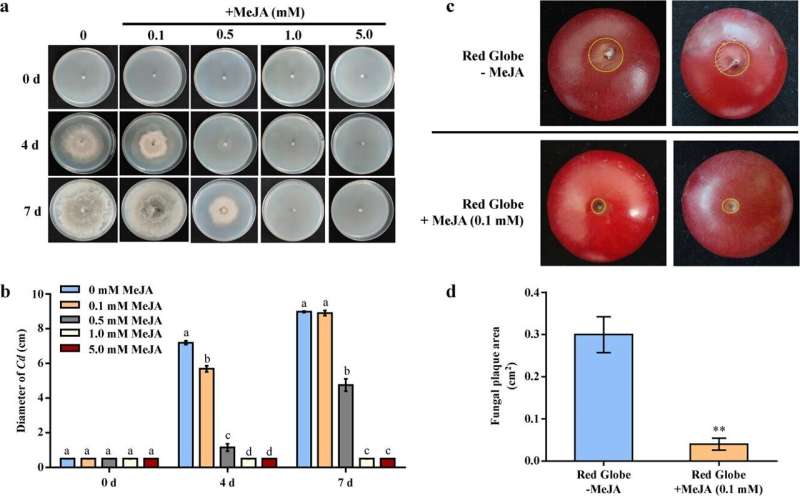This article has been reviewed according to Science X's editorial process and policies. Editors have highlighted the following attributes while ensuring the content's credibility:
fact-checked
proofread
Grape white rot resistance and the role of VvWRKY5 in enhancing pathogen defense through the jasmonic acid pathway

Grape white rot, caused by Coniella diplodiella (Speg.) Sacc. (Cd), significantly impacts grape production and quality, highlighting the need for effective disease management strategies beyond fungicide use due to concerns over food safety and environmental impact. WRKY transcription factors are pivotal in plant pathogen resistance, yet their roles in combating grape white rot are poorly understood. This knowledge gap highlights the need for research into how WRKY transcription factors can enhance grape resistance to white rot, offering a pathway to more sustainable disease control methods.
In August 2023, Horticulture Research published a study titled "VvWRKY5 enhances white rot resistance in grape by promoting the jasmonic acid pathway."
In this study, researchers first applied exogenous methyl jasmonate (MeJA) and salicylic acid (SA) to grape berries and monitored Cd growth. They discovered that both MeJA and SA inhibited Cd growth, with MeJA showing a stronger inhibitory effect, particularly at higher concentrations. A specific concentration of 0.1 mM MeJA not only effectively suppressed Cd growth but also significantly enhanced Cd resistance in treated grape fruits, as evidenced by reduced fungal diffusion and smaller fungal plaque areas compared to untreated fruits.
Further investigations focused on the role of the WRKY IIe subfamily member VvWRKY5, which was found to be highly induced by Cd infection and MeJA treatment. Transient silencing and overexpression studies of VvWRKY5 in grape fruits demonstrated its positive role in enhancing Cd resistance, corroborated by increased reactive oxygen species (ROS) production and antioxidant enzyme activities in overexpressed VvWRKY5 grape calli.
RNA sequencing analysis revealed that VvWRKY5 overexpression altered the expression of genes involved in jasmonic acid pathways and other resistance-related processes. VvWRKY5 was found to directly bind to the promoters of VvJAZ2 and VvMYC2, key genes in the JA signaling pathway, indicating its regulatory role in this pathway. Additionally, physical interaction between VvWRKY5 and VvJAZ2 was demonstrated through various assays, suggesting a complex mechanism of action where VvWRKY5 enhances Cd resistance by modulating JA-mediated signaling pathways.
The study concluded that VvWRKY5 positively regulates white rot resistance in grape by engaging in the JA signaling pathway, affecting the transcription of JA pathway-related genes, and interacting with VvJAZ2 to influence the expression of VvJAZ2 and VvMYC2. These findings highlight the intricate network of plant defense mechanisms against pathogens and highlight the potential of genetic and molecular approaches in developing disease-resistant grape varieties.
More information: Zhen Zhang et al, VvWRKY5 enhances white rot resistance in grape by promoting the jasmonic acid pathway, Horticulture Research (2023). DOI: 10.1093/hr/uhad172
Provided by BioDesign Research





















